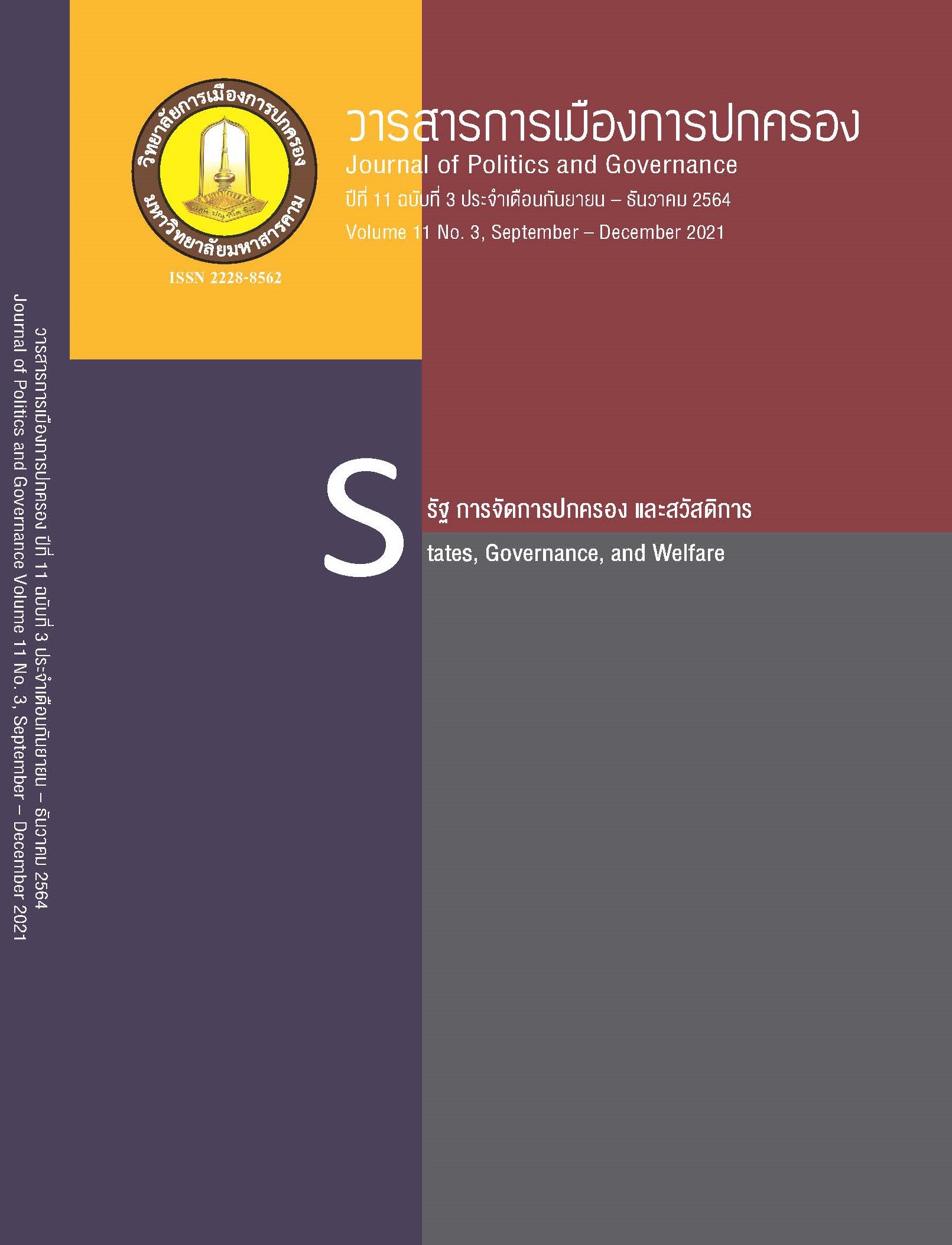The Opportunities and Challengings of OTOP Village Development for Tourism At Tha Li district in Loei Province
Main Article Content
Abstract
The purpose of this research was 1) to analyze the strengths, weaknesses, opportunities and obstacles of the OTOP village development for tourism in two villages located in Tha Li district in Loei province, and 2) to propose the strategies for the OTOP village development for tourism in these two villages in Tha Li district, Loei Province using qualitative research. The population included the village leader, the village committee members and a sample of people from the two villages, which are Ban Pak Huai, Nong Phue sub-district, Tha Li district and Ban Ahi, Ahi sub-district, Tha Li district, Loei province, which is the area for the research. In each village, a total of 20 people participated in the study, and the tool used in the study was an interview form by group discussion. The findings showed that, regarding the OTOP villages for tourism, the two villages in Tha Li district, Loei province, including Ban Pak Huai, Tha Li district, Loei province and Ban Ahi, Loei district, Loei province, the strengths can be separated into five aspects of 1) the religious landmarks and archaeological sites, 2) the natural attractions, 3) the traditions and local wisdom, 4) the field of learning resources, and 5) the community food and products. The weaknesses include the lack of landscape improvement, the need for the villages’ attractions to be clean and attractive, and the lack of a market to sell goods. The opportunities are to have an area next to the Lao People's Democratic Republic, where there is a major tourist route in Loei, and In winter, there is the conservation and succession of folk traditions. However, the barriers are the inadequate government funding budgets, there are no buses arriving at the village, and the lack of publicity for tourists to know about these villages. In conclusion, the villages are part of the strategic development for the OTOP tourism in Tha Li district, Loei province, which is composed of five points, namely 1) the development of tourism, 2) the cultural tourism development, 3) the participation of sustainable communities, 4) the OTOP product development for tourism, and 5) the standard tours.
Article Details
References
กรมพัฒนาชุมชน. (2561). คู่มือบริหารโครงการหมู่บ้าน OTOP เพื่อการท่องเที่ยว (OTOP Village) 8 เส้นทาง. กรุงเทพฯ: สำนักส่งเสริมภูมิปัญญาท้องถิ่นและวิสาหกิจชุมชน.
กรมส่งเสริมการปกครองส่วนท้องถิ่น. (2550). มาตรฐานการส่งเสริมการท่องเที่ยว. กรุงเทพฯ: สำนักมาตรฐานการบริหารงานองค์กรปกครองส่วนท้องถิ่น.
ไกรฤกษ์ ปิ่นแก้ว. (2556). การท่องเที่ยวเชิงวัฒนธรรม. สืบค้นจาก http://tourism-dan1.blogspot.com
ณัฐวัฒน์ เทพคำดี. (2550). ความคิดเห็นของบุคลากรการท่องเที่ยวที่มีต่อการสร้างสะพานข้ามแม่น้ำโขงแห่งที่ 2 กับการท่องเที่ยวในเขตเทศบาลเมืองมุกดาหาร. (วิทยานิพนธ์ ศศ.ม.). มหาวิทยาลัยราชภัฏอุบลราชธานี.
ทฤษฎีองค์การและการจัดการเชิงกลยุทธ์ชั้นสูง. (2555). SWOT Analysis ด้าน Planning. สืบค้นจาก http://promrucsa-dba04.blogspot.com/2012/10/swot-analysis-swot-swot-humphrey-swot-2.html
น้ำทิพย์ เมืองอินทร์. (2556). ปัจจัยที่มีอิทธิพลต่อจำนวนนักท่องเที่ยวจากกลุ่มประเทศอนุภูมิภาคลุ่มน้ำโขงในประเทศไทย. (วิทยานิพนธ์ ศ.ม.). มหาวิทยาลัยเชียงใหม่.
บุญเลิศ จิตตั้งวัฒนา. (2557). การพัฒนาการท่องเที่ยวแบบยั่งยืน. กรุงเทพฯ: ธรรมสาร.
มณีรัตน์ สุพร. (2558). กลยุทธ์การตลาด 7s กรอบแนวคิดของ McKinsey. สืบค้นจาก https://www.im2market.com/2015/01/21/650
รําไพ กาแก้ว. (2541). ประวัติบ้านอาฮี. เลย: โรงเรียนบ้านอาฮี. โรงเรียนบ้านปากห้วย. (2552). ประวัติบ้านปากห้วย. เลย: โรงเรียนบ้านปากห้วย.
มหาวิทยาลัยราชภัฏเพชรบุรี, คณะวิทยาการจัดการ. (2562). การจัดการเชิงกลยุทธ์. สืบค้นจาก https://www.mit.pbru.ac.th/upload/course/
วรรณา วงษ์วานิช. (2546). ภูมิศาสตร์การท่องเที่ยว. กรุงเทพฯ: มหาวิทยาลัยธรรมศาสตร์.
ศริญญา สุรี. (2558). ชาวเวียดนามอพยพ: นายทุนยุค “ไทยใหม่” และการกลายเป็นชนชั้นนำเมืองชายแดน. เชียงใหม่: ศูนย์อาเซียนศึกษามหาวิทยาลัยเชียงใหม่.
ศุลีพร อานันทประภา. (2551). กลยุทธ์การท่องเที่ยวจังหวัดชลบุรี. (วิทยานิพนธ์ ศ.ม.). มหาวิทยาลัยรามคำแหง.
สาระดีดี.คอม. (2559). การท่องเที่ยวแบบยั่งยืน (Sustainable Tourism). สืบค้นจาก http://www.sara-dd.com/index.php?option=com_content&view
=article&id=219
สุวารีย์ ศรีปูระ และคณะ. (2548). การพัฒนาคุณภาพและมาตรฐานการท่องเที่ยวชายแดนลุ่มน้ำเหือง-โขง: กรณีศึกษา แก่งคุ้ดคู้ อำเภอเชียงคาน จังหวัดเลย. มหาวิทยาลัยราชภัฏเลย.
สำนักงานพัฒนาชุมชนจังหวัดเลย. (2561). โครงการหมู่บ้าน OTOP เพื่อการท่องเที่ยว (OTOP Village) 8 เส้นทาง จังหวัดเลย. เลย: สำนักงานพัฒนาชุมชนจังหวัดเลย.
อติสันติ์ ภูวพิพัฒนวงศ์. (2562). ความหมายและความสำคัญของการบริหารและการพัฒนา.สืบค้นจาก https://sites.google.com/site/wongtham/document
อนุรัตน์ อินทร. (2551). ยุทธศาสตร์การท่องเที่ยวจังหวัดเชียงรายเป็นศูนย์กลางเชื่อมโยง ในอนุภูมิภาคลุ่มน้ำโขงตอนบน. (วิทยานิพนธ์ ปร.ด.). มหาวิทยาลัยราชภัฏเชียงราย.
อรนุช ศิลป์มณีพันธ์. (2547). ลักษณะชายฝั่งทะเลที่พึงประสงค์ของนักท่องเที่ยวบริเวณชายฝั่งทะเลประเทศไทย. กรุงเทพฯ: มหาวิทยาลัยศรีนครินทร์วิโรฒประสานมิตร.


